Brainstorming tools help teams perform at their creative and productive capacities.
The best-case scenario is for everyone on the team to fully engage and participate, firing on all cylinders.
Collaboration is happening, all voices are heard, and everyone is inspired. Winning ideas are forming, developing, and morphing into an actual plan. A plan with actionable, assignable, and trackable steps and related deadlines.
Best of all, the meeting adjourns on time.
But how do you choose the right tool for your team? Read on to learn what to consider when looking for online brainstorming tools, and check out our top picks for 2025.
What is a brainstorming tool?
Fifty-eight percent of people struggle with brainstorming in a virtual meeting. Brainstorming tools help teams generate, organize, and share ideas within a visual collaboration platform. This structured virtual environment encourages creativity, innovation, and engagement.
Fifty-five percent of people are unclear about the next steps at the end of a meeting. Since brainstorming tools help organize ideas visually, it’s easier to see connections, prioritize concepts, and develop coherent strategies.
These strategies can then be broken down into actionable tasks, giving attendees more precise direction.
In addition, brainstorming tools enable team members to collaborate in real-time or asynchronously, regardless of their physical location. With the rise of remote work, they offer a way for distributed teams to brainstorm effectively and stay connected.
Finally, these tools allow teams to document ideas, discussions, and decisions, providing a valuable reference for future projects.
What are the rules of brainstorming?
Remember the following rules of thumb for a smooth, productive, and time-efficient brainstorming session.
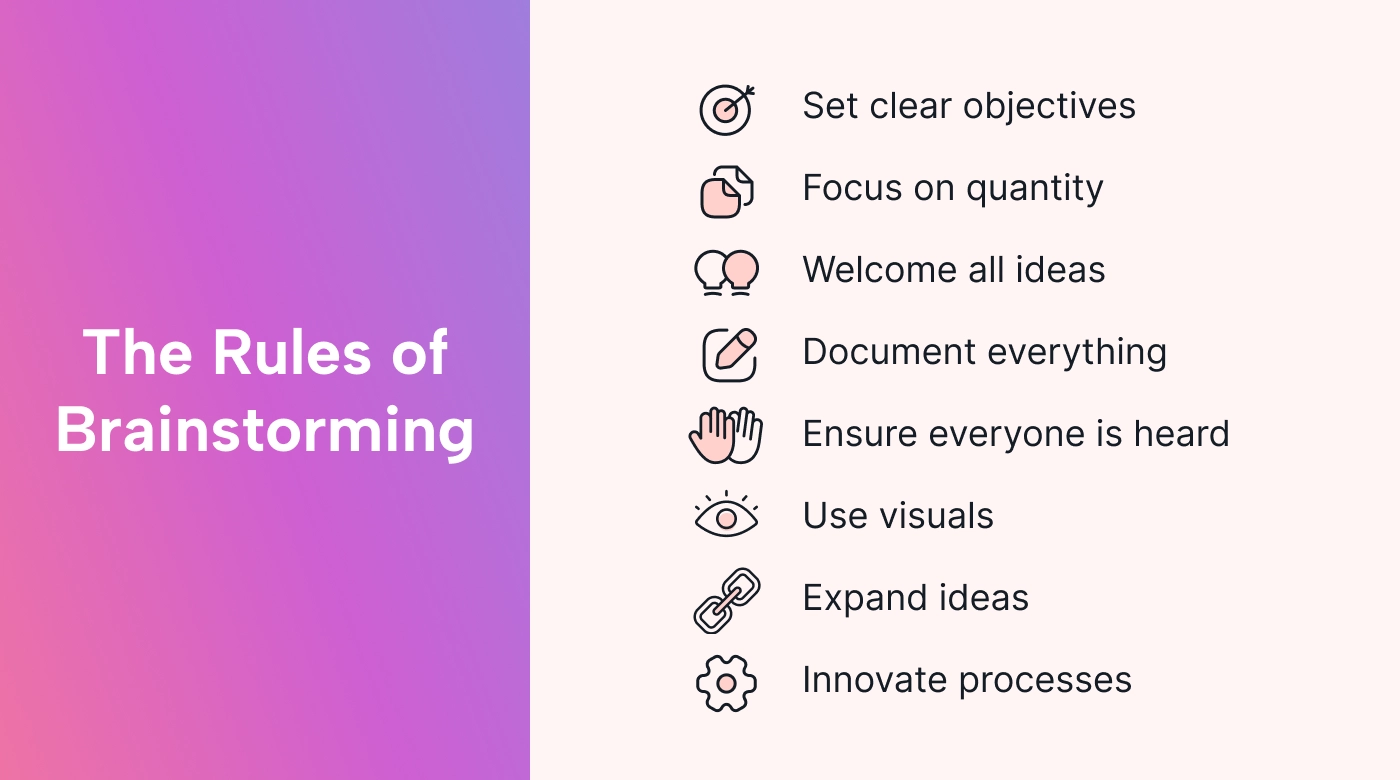
1. Set clear objectives
Clearly define the problem or goal to direct the brainstorming session. Set ground rules to establish context and to keep participants aligned and on track. Brainstorming tools contain features that help you manage time and visualize objectives.
2. Focus on quantity
Prime everyone's brain pumps to get the ideas flowing. Encourage the generation of numerous ideas without judgment. Idea assessment will come later. Tools with timer features or idea prompts, like sticky note boards, can spur rapid idea generation.
3. Welcome all ideas
Create a nonjudgmental environment where all ideas are accepted. Encourage any unusual, wild, and big ideas without criticism. Some of the greatest inventions, innovations, and campaigns started as ideas that initially seemed unorthodox.
Many brainstorming tools allow anonymous idea submission for those who feel more comfortable expressing bold ideas that way.
4. Document every single idea
Capture all ideas, even seemingly outlandish ones, as they can inspire later. Digital tools ensure no lost ideas and provide a record for future reference.
5. Ensure everyone’s ideas are heard
Create a welcoming environment where everyone feels comfortable contributing their thoughts. This includes introverts, those shy about sharing their opinion in general, and those hesitant to share their opinion with senior staff members or management.
Make sure one conversation is happening at a time so no one’s being drowned out or overlooked. Brainstorming tools have collaboration features that help ensure everyone’s ideas are accounted for.
6. Use visuals
Visual aids like charts, graphs, or digital whiteboards help illustrate complex ideas, making them easier to understand and build upon. Good brainstorming tools support various visual media and file types.
7. Combine, build on, and improve ideas
Once all ideas are on the table, determine which can be combined, built upon, or improved. Tools that enable the categorizing, clustering, or merging of ideas help refine and develop them into actionable solutions.
8. Innovate your process
Sometimes, switching up your brainstorming process can help spur creativity. Experiment with different techniques and tools to find what works best for your team.
Brainstorming tools with collaboration options and customizable workflows simplify this effort.
What are 12 brainstorming techniques?
There are many different brainstorming techniques, but let’s look at some of the most popular methods used by teams and supported by various brainstorming tools.
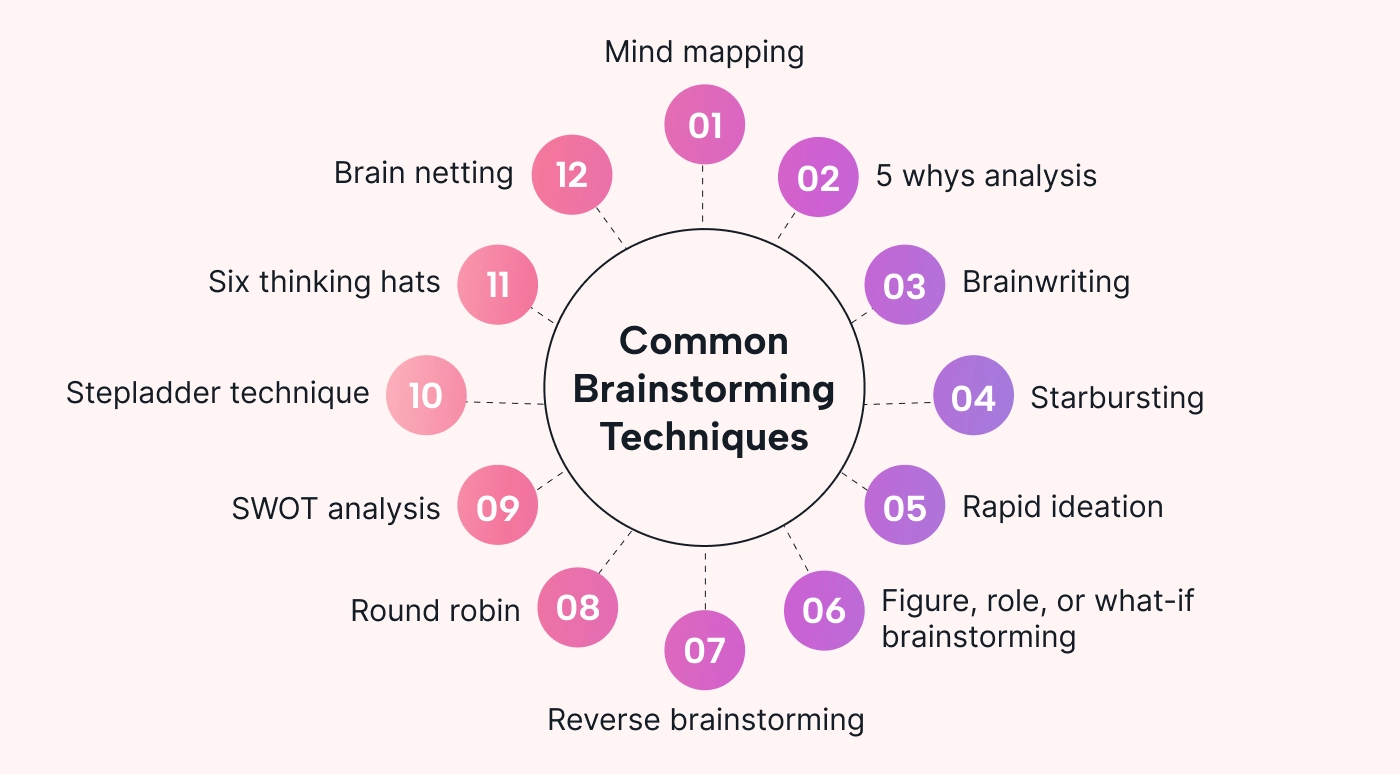
1. Mind mapping
Brainstorm ideas branching out from a central one to explore connections and encourage streams of thought.
2. Five whys analysis
Starting with an idea or problem, ask "why" five times over to get to the root of an issue, gaining a deeper understanding.
3. Brainwriting
Participants write down and share their ideas while building upon their neighbors' opinions. After a few passes, all idea threads are posted and discussed within the group. This technique encourages equal participation, more diverse input, and fleshed-out ideas.
4. Starbursting
Brainstorm possible questions rather than ideas about a topic to explore all angles comprehensively.
5. Rapid ideation
Churn out ideas within a short time limit to avoid overthinking and second-guessing.
6. Figure, role, or what-if brainstorming
Brainstorm ideas from the perspectives of different figures, titles, or scenarios to gain a deeper understanding.
7. Reverse brainstorming
Brainstorm problems or obstacles related to a topic rather than solutions to address underlying issues in advance.
8. Round robin
Share ideas individually to ensure equal participation and prevent anyone from dominating the discussion.
9. SWOT analysis
Brainstorm an idea or project's strengths, weaknesses, opportunities, and threats. This method helps identify areas for improvement and potential risks in advance.
10. Stepladder technique
Propose and integrate ideas individually to incorporate all voices and prevent groupthink.
11. Six thinking hats
Explore a topic from six different perspectives and thinking styles before making decisions.
12. Brain netting
Utilize long-term anonymous and spontaneous brainstorming via a virtual collaborative platform. This technique allows for diverse, thoughtful input and ensures all voices are heard.
Key features of brainstorming tools
Look for the following important features when considering different online brainstorming tools for your business.
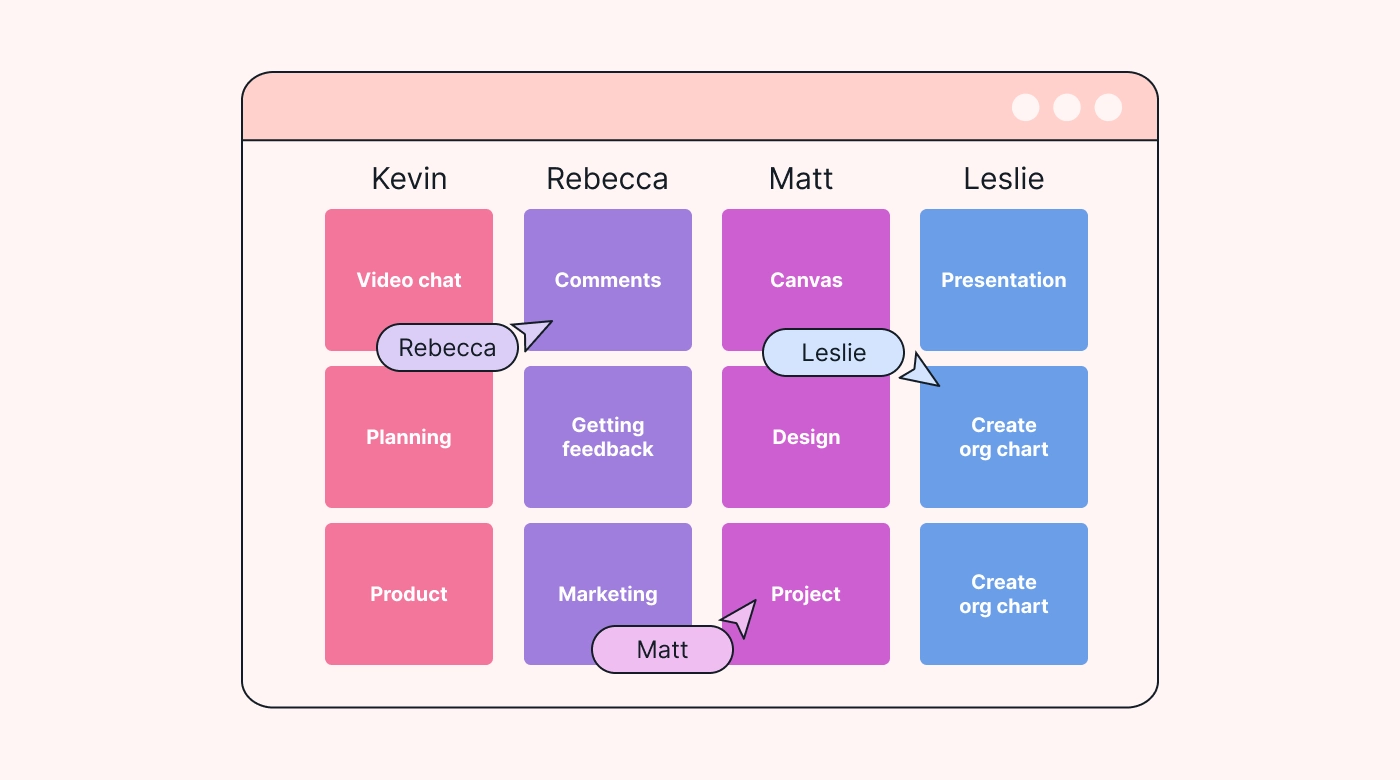
Usability
Consider intuitive and easy-to-navigate options that require minimal training. Then, your team can get started quickly and focus fully on brainstorming.
Collaboration capabilities
Real-time and async collaboration features enable teams to ideate and create together.
Customization
Brainstorming tools should offer flexibility to adapt to different brainstorming methods. They should also cater to group needs and individual preferences.
Integrations
Seamless integration with the team's other tools streamlines workflows and enhances productivity.
Cross-platform compatibility
Compatibility across devices and operating systems ensures accessibility for all team members.
Idea-capture tools
Your options should offer various ways to capture ideas to accommodate different brainstorming styles.
Templates and frameworks
Pre-built templates and frameworks help kickstart brainstorming sessions, providing a structured approach and saving time.
9 best tools for brainstorming in 2025 (1200 Words)
1. Miro
Best for: Visual project planning
Miro is a versatile virtual whiteboard platform designed for visual planning. Various industries and teams use it for brainstorming, agile planning, user story mapping, and more. The intuitive interface and extensive customizable features make it ideal for brainstorming sessions.
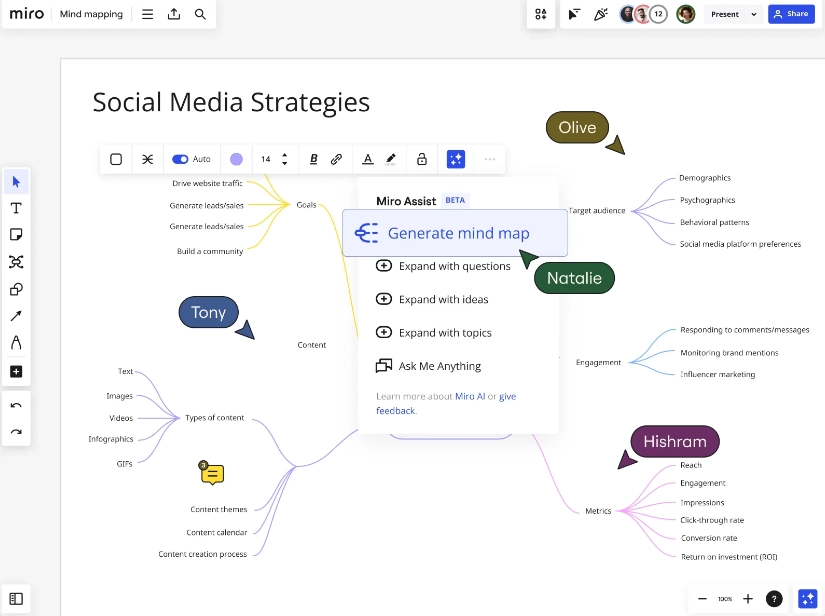
Users can create unlimited boards to add sticky notes, draw, add images, and structure their ideas using various templates. Miro's real-time collaboration features allow team members to work together from any location.
Integrations with popular third-party apps streamline workflows and make it easy to incorporate ideas into existing projects. Miro is highly customizable, allowing users to tailor their boards to suit their needs and preferences. Its cross-platform compatibility ensures team members can access it from any device for seamless and efficient collaboration.
Price (billed annually):
- Free
- Starter - $8 per month per user
- Business - $16 per month per user
- Enterprise - Contact for pricing
The Business plan includes a 14-day free trial for Free and Starter users.
2. Mural
Best for: Creative collaboration
Mural is another powerful online whiteboard tool designed for visual collaboration. It offers a range of creative tools and features tailored to brainstorming, design, and innovation processes.
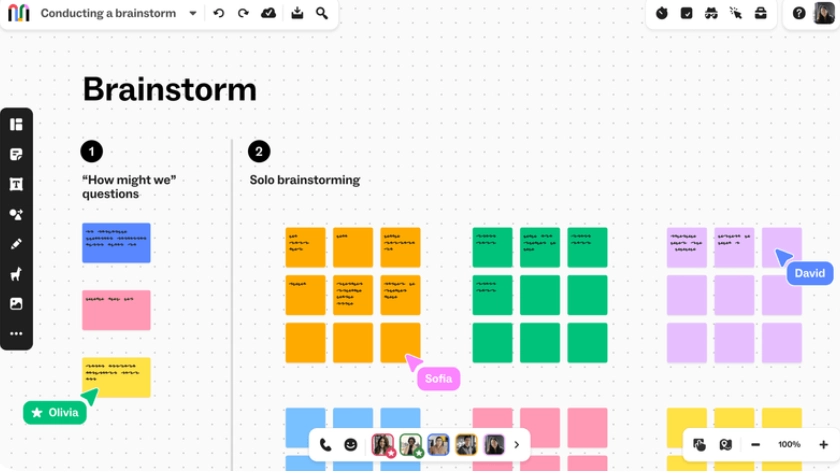
Mural has a modern interface designed to be visually appealing and engaging. It allows users to create unlimited boards and add elements such as sticky notes, drawings, and images.
It also offers templates and frameworks to guide brainstorming sessions, making it easy for teams to start.
Mural's voting, commenting, and real-time editing features facilitate remote collaboration. Integration with over 40 popular tools enhances usability within existing workflows.
Price (billed annually):
- Free
- Team+ - $9.99 per month per user
- Business - $17.99 per month per user
- Enterprise - Contact for pricing
3. Coggle
Best for: Intricate, collaborative mind mapping
Coggle is an intuitive online mind-mapping and flowcharting tool.
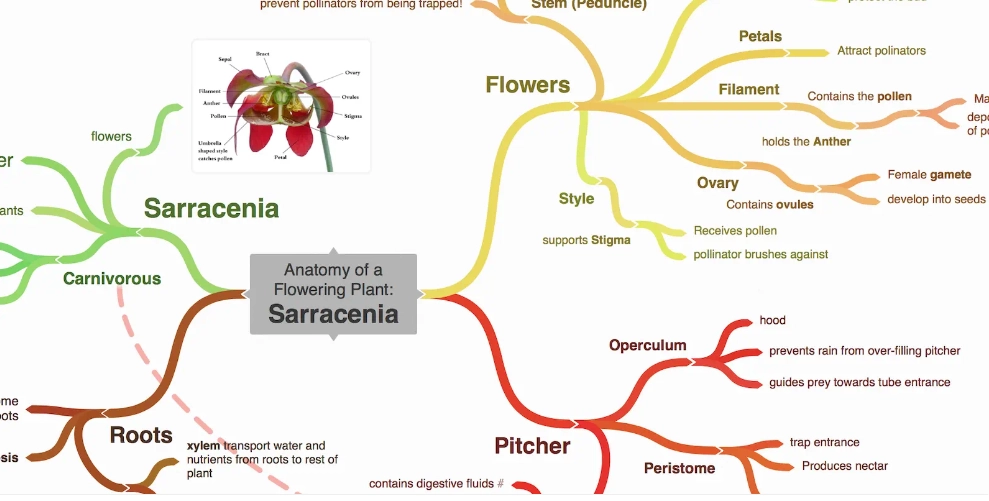
Key features include creating and joining branches and sub-branches, creating loops, and establishing multiple starting points. You can customize your diagrams by adding text, images, and links.
Real-time editing features allow multiple users to work on the same diagram simultaneously. This makes it ideal for online brainstorming sessions or project planning, especially with remote teams.
Teams can create unlimited public diagrams and upload unlimited images; paid plans include unlimited private diagrams. Users can also share diagrams with others by inviting collaborators or generating a shareable link.
Price:
- Free
- Awesome - $5 per month
- Organization - $8 per month
4. Lucidchart/Lucidspark
Best for: Flowcharts and overall data visualization
Lucidchart is a versatile diagramming and visual communication tool. It offers various templates and shapes that teams can use to create various diagrams.
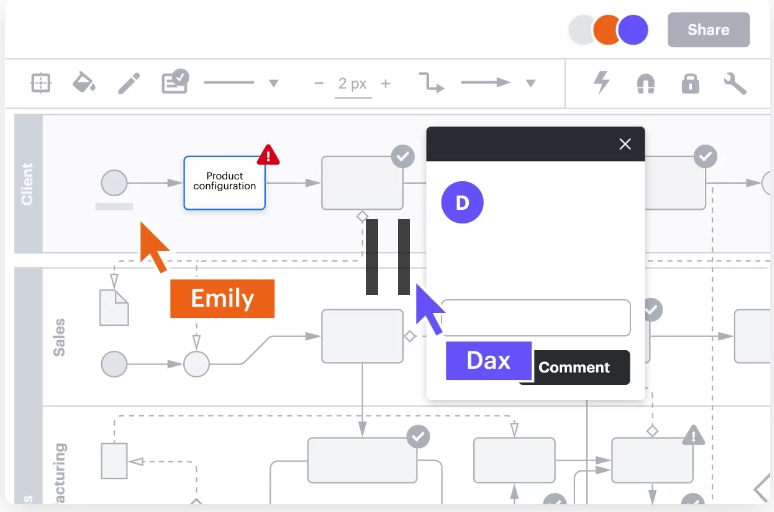
Create and customize diagrams with colors, shapes, images, text, and live data. Team collaboration features include co-authoring, in-editor chat, shape-specific comments, and collaborative cursors.
Lucidchart's sister tool, Lucidspark, is also designed for brainstorming and collaboration. Its infinite canvas offers a more flexible and dynamic workspace compared to Lucidchart.
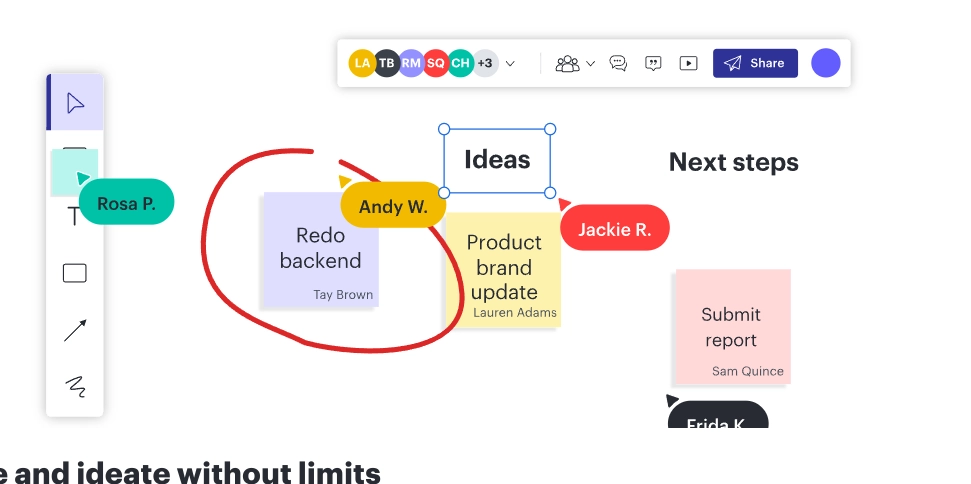
Additional brainstorming features include breakout boards, a built-in timer, sticky notes, drawing tools, voting, gathering and sorting, and templates.
Combine both tools to seamlessly go from ideation and planning to workflow building and task management.
Price for Lucidchart or Lucidspark:
- Free
- Individual - $9 per month
- Team - $11 per user per month
- Enterprise - Contact for pricing
Lucidchart and Lucidspark offer a 7-day free Individual and Team plans trial.
Price for Lucidchart and Lucidspark Bundle:
- Free
- Individual Bundle - $13.50 per month
- Team Bundle - $16.50 per user per month
- Enterprise - Contact for pricing
The Individual and Team bundle plans also include 7-day free trials.
5. Scapple
Best for: Virtual note-taking and solo brainstorming
Scapple is a freeform interface where users can jot down ideas, make connections, and organize their thoughts visually. It’s a versatile tool for brainstorming, idea generation, and visual organization.
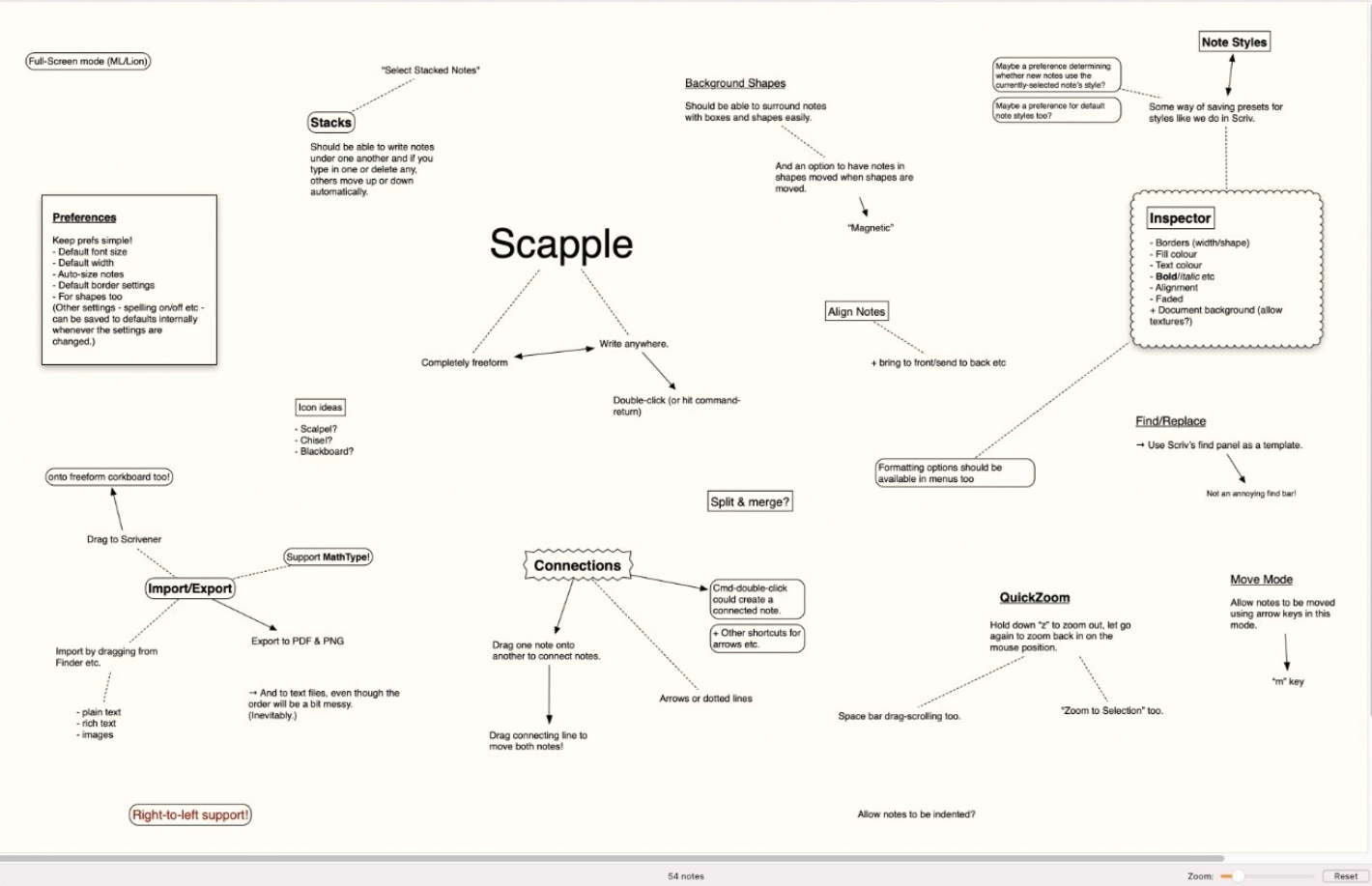
Make notes anywhere on the digital canvas, allowing for non-linear thinking and flexible organization. Connect notes with drag-and-drop lines or arrows to show relationships between ideas.
Users can customize the appearance of notes, including color, font, and shape, to represent different ideas or concepts. Simple text formatting options make it easy to emphasize or categorize ideas.
Teams can export their Scapple documents to various formats or share them with others for collaboration.
Price:
The Standard License costs $20.99. Scrapple sells single-platform licenses, so you would have to buy two licenses to run the software on both Mac and Windows.
Scapple offers a unique free trial in which you get 30 days of use rather than a consecutive 30-day period during which you may or may not use it on some days. Your free trial ends once the platform registers that you have used it for 30 days, even if that’s spread over 60 or even 90 days.
6. Stormboard
Best for: Structured, high-level brainstorming and planning
Stormboard is a powerful online brainstorming and collaboration tool. It offers a digital workspace for teams to ideate, organize, and prioritize ideas.
While Stormboard provides a visual workspace, it’s more suited for structured brainstorming and planning activities.
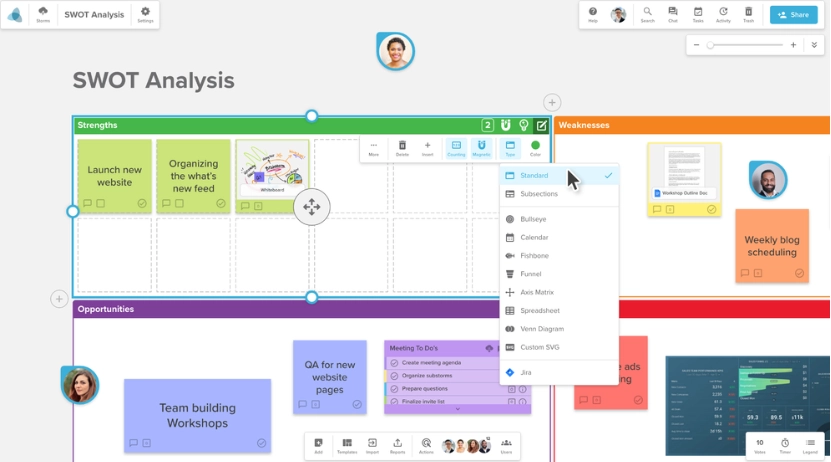
Stormboard provides features explicitly designed for brainstorming and planning, including sticky notes, interactive whiteboards, an infinite canvas, and digital workspaces called Storms.
Over 250 customizable smart templates make getting started easy. Voting and rating tools help teams prioritize and focus on the most promising ideas.
Real-time collaboration enables teams to brainstorm ideas together regardless of their location. Project management tools help teams shift seamlessly from brainstorming ideas to assigning, tracking, and organizing tasks.
Stormboard integrates with popular tools like Zapier, Slack, and Google Drive, allowing seamless integration into existing workflows.
Price (billed annually):
- Personal - Free
- Business - $8.33 per user per month
- Enterprise - Contact for pricing
The Business plan comes with a 30-day free trial.
7. Bubbl.us
Best for: Simple mind mapping for individuals or small teams
Bubbl.us is a simple and intuitive online mind-mapping tool. It offers a straightforward approach to brainstorming ideas, organizing thoughts, and visualizing concepts.
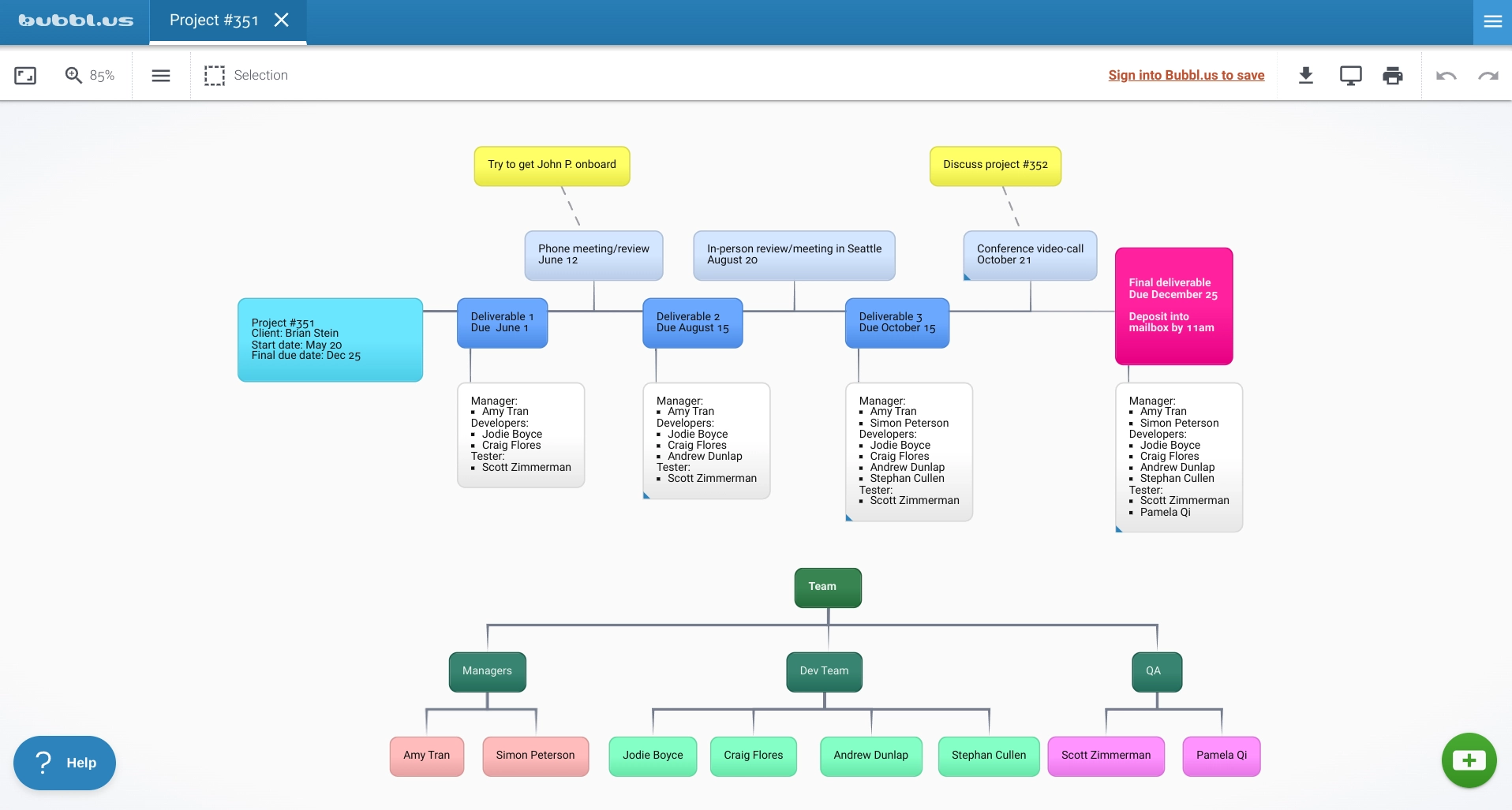
The user-friendly interface makes creating and customizing mind maps with colors, images, and shapes easy.
This solution suits individuals or teams seeking a simple and effective tool for brainstorming ideas, outlining projects, or planning strategies. Its ease of use is perfect for those new to mind mapping or seeking a hassle-free solution for organizing their thoughts.
Price:
- Basic - Free
- Premium - $4.91 per month
- Team - $59 per year per user
All paid plans include a 10-day free trial.
8. WiseMapping
Best for: Free collaborative mind mapping
WiseMapping is a free, open-source online mind-mapping tool emphasizing collaboration and simplicity. It provides a platform for creating detailed and structured mind maps, with options to add icons, links, and notes to nodes.
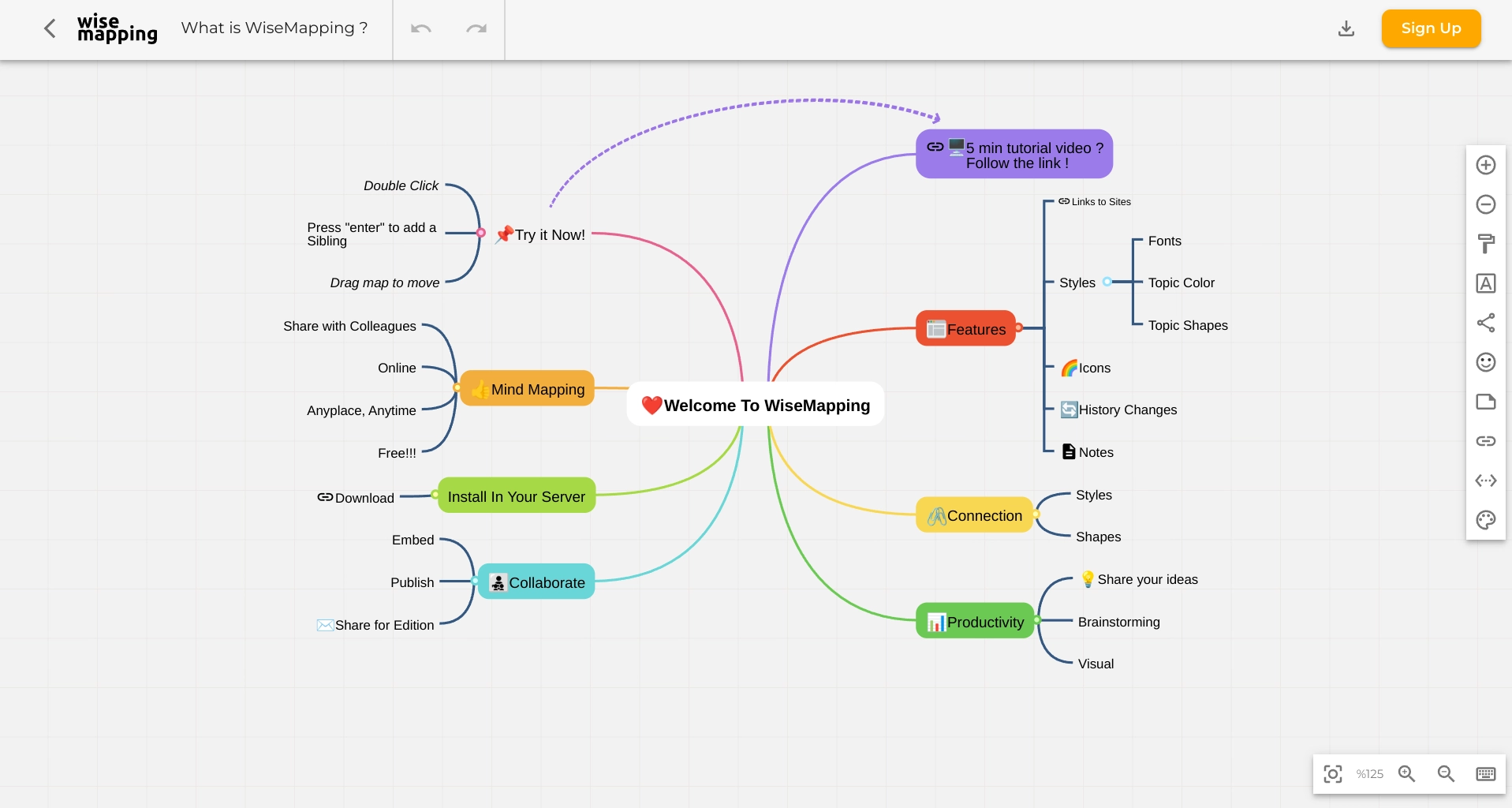
Team members can co-edit the same mind map with real-time collaboration features. The user-friendly interface and focus on collaboration make WiseMapping ideal for brainstorming sessions or project planning.
Price:
WiseMapping is free to use online, and you can install, license, or modify it to your needs and preferences.
9. MindMeister
Best for: Extensive customization
MindMeister is a popular online mind-mapping tool known for its ease of use, collaboration features, and customization options. It offers various templates, styles, and formatting options for visually appealing mind maps.
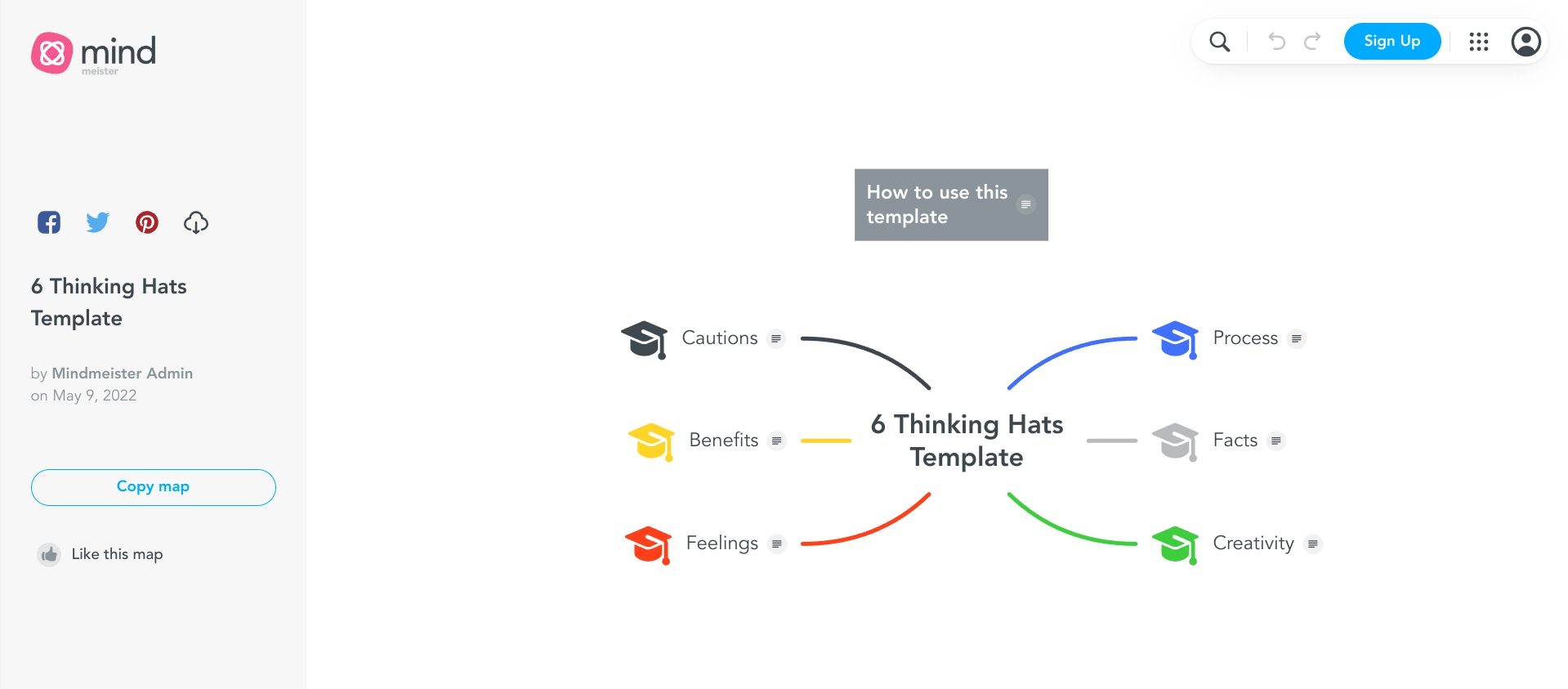
Customization options for organizing your mind maps include:
- Individual topic styling
- Line styling
- Tintable images and emojis
- Freely-positioned topics
- Markdown syntax
- Mixed map layouts
- Templates and themes
- Customizable connection lines
Collaboration features such as brainstorm mode and in-map commenting enable teams to brainstorm ideas and contribute simultaneously.
Seamless integration with the MeisterTask tool allows you to convert mind map topics into trackable project tasks. MeisterNote integration enables you to embed the mind map into a document and track changes to the map from MeisterNote in real time.
Price (billed annually):
- Basic - Free
- Personal - $6.50 per month per user
- Pro - $10.50 per month per user
- Business - $15.50 per month per user
The best brainstorming tool to support your next meeting
The right tool for your team ensures no person or idea is left behind. It fosters creativity, collaboration, and organization regardless of the type of team you have.
It also helps you get a lot done in a limited time, so your schedule stays on track and your free time remains your own.
Check out the brainstorming tools listed above using their free trials and freemium plans to determine which may be the right fit for your business.
As ideas take shape and tasks are formed, assigned, and scheduled beyond the brainstorming session, ensure your team has an intelligent planner like Motion to keep everyone on track.
Try Motion today to see how it effortlessly balances your schedule and workload. Walk into the next brainstorming meeting refreshed and well-rested rather than stretched thin and burnt out.

Tiffany has a BA in Business Management and years of experience writing for SaaS and digital marketing blogs. She bristles at typos, broken links, and 2015 statistics circulated through 2023 content. When not writing, Tiffany's either reading, baking, or mothering her spoiled rescue pittie.




